时间序列数据是一种在一段时间内收集的数据类型,它通常用于金融、经济学和气象学等领域,经常通过分析来了解随着时间的推移的趋势和模式
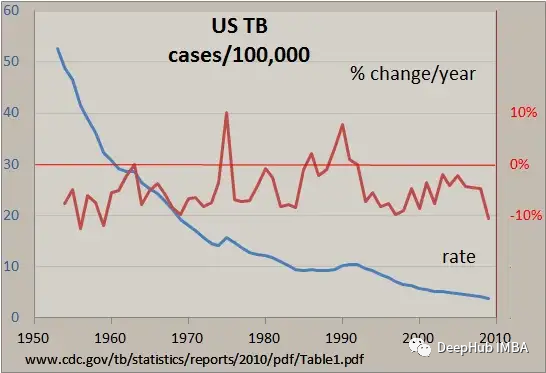
Pandas是Python中一个强大且流行的数据操作库,特别适合处理时间序列数据。它提供了一系列工具和函数可以轻松加载、操作和分析时间序列数据。
在本文中,我们介绍时间序列数据的索引和切片、重新采样和滚动窗口计算以及其他有用的常见操作,这些都是使用Pandas操作时间序列数据的关键技术。
数据类型
Python
在Python中,没有专门用于表示日期的内置数据类型。一般情况下都会使用datetime模块提供的datetime对象进行日期时间的操作。
importdatetime
t=datetime.datetime.now()
print(f"type: {type(t)} and t: {t}")
#type: <class 'datetime.datetime'> and t: 2022-12-26 14:20:51.278230
一般情况下我们都会使用字符串的形式存储日期和时间。所以在使用时我们需要将这些字符串进行转换成datetime对象。
一般情况下时间的字符串有以下格式:
YYYY-MM-DD(e.g. 2022-01-01)YYYY/MM/DD(e.g. 2022/01/01)DD-MM-YYYY(e.g. 01-01-2022)DD/MM/YYYY(e.g. 01/01/2022)MM-DD-YYYY(e.g. 01-01-2022)MM/DD/YYYY(e.g. 01/01/2022)HH:MM:SS(e.g. 11:30:00)HH:MM:SS AM/PM(e.g. 11:30:00 AM)HH:MM AM/PM(e.g. 11:30 AM)
strptime 函数以字符串和格式字符串作为参数,返回一个datetime对象。
string='2022-01-01 11:30:09'
t=datetime.datetime.strptime(string, "%Y-%m-%d %H:%M:%S")
print(f"type: {type(t)} and t: {t}")
#type: <class 'datetime.datetime'> and t: 2022-01-01 11:30:09
格式字符串如下:
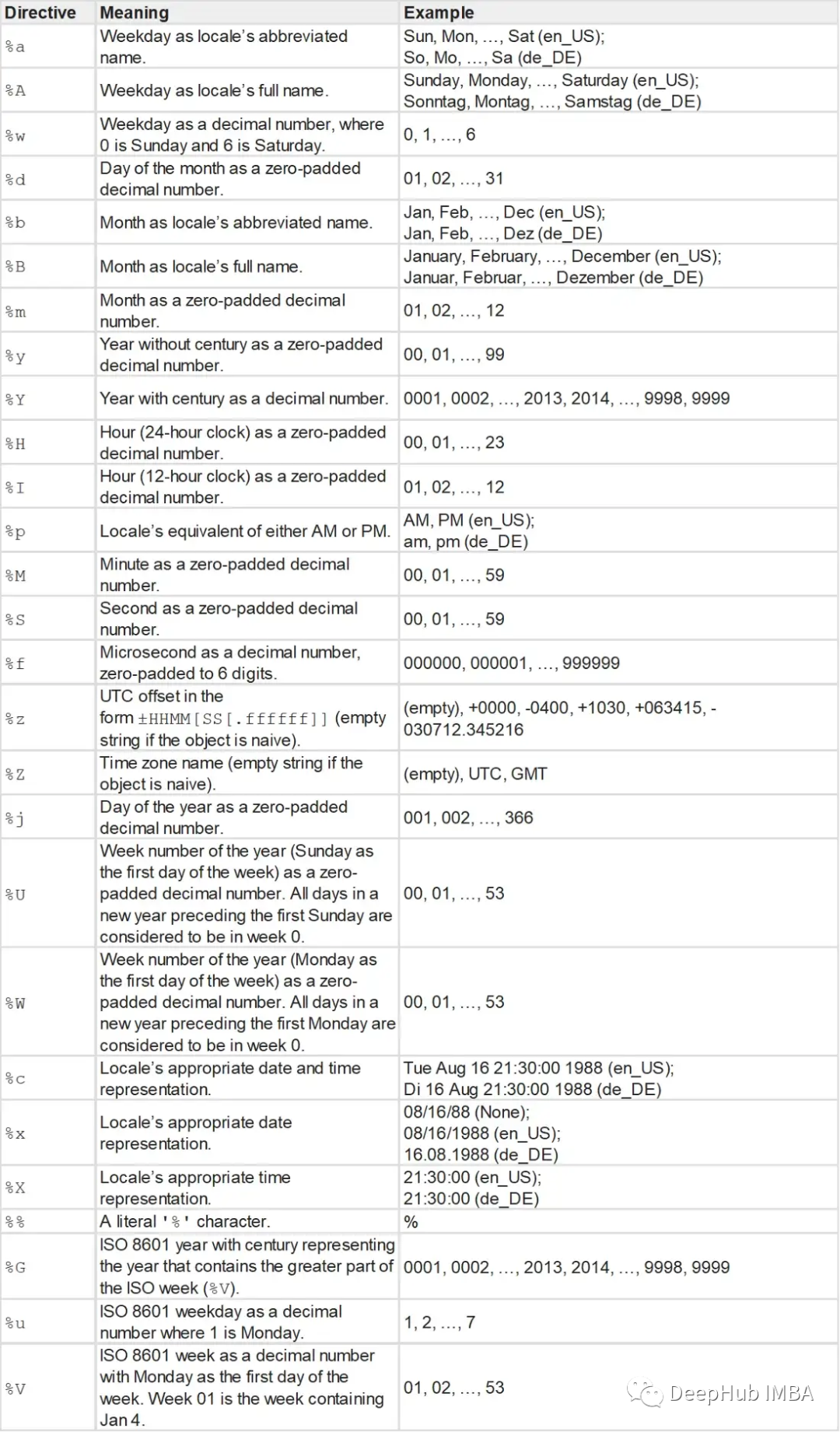
还可以使用strftime函数将datetime对象转换回特定格式的字符串表示。
t=datetime.datetime.now()
t_string=t.strftime("%m/%d/%Y, %H:%M:%S")
#12/26/2022, 14:38:47
t_string=t.strftime("%b/%d/%Y, %H:%M:%S")
#Dec/26/2022, 14:39:32
Unix时间(POSIX时间或epoch时间)是一种将时间表示为单个数值的系统。它表示自1970年1月1日星期四00:00:00协调世界时(UTC)以来经过的秒数。
Unix时间和时间戳通常可以互换使用。Unix时间是创建时间戳的标准版本。一般情况下使用整数或浮点数据类型用于存储时间戳和Unix时间。
我们可以使用time模块的mktime方法将datetime对象转换为Unix时间整数。也可以使用datetime模块的fromtimestamp方法。
#convert datetime to unix time
importtime
fromdatetimeimportdatetime
t=datetime.now()
unix_t=int(time.mktime(t.timetuple()))
#1672055277
#convert unix time to datetime
unix_t=1672055277
t=datetime.fromtimestamp(unix_t)
#2022-12-26 14:47:57
使用dateutil模块来解析日期字符串获得datetime对象。
fromdateutilimportparser
date=parser.parse("29th of October, 1923")
#datetime.datetime(1923, 10, 29, 0, 0)
Pandas
Pandas提供了三种日期数据类型:
1、
Timestamp
或
DatetimeIndex
:它的功能类似于其他索引类型,但也具有用于时间序列操作的专门函数。
t=pd.to_datetime("29/10/1923", dayfirst=True)
#Timestamp('1923-10-29 00:00:00')
t=pd.Timestamp('2019-01-01', tz='Europe/Berlin')
#Timestamp('2019-01-01 00:00:00+0100', tz='Europe/Berlin')
t=pd.to_datetime(["04/23/1920", "10/29/1923"])
#DatetimeIndex(['1920-04-23', '1923-10-29'], dtype='datetime64[ns]', freq=None)
2、
period
或
PeriodIndex
:一个有开始和结束的时间间隔。它由固定的间隔组成。
t=pd.to_datetime(["04/23/1920", "10/29/1923"])
period=t.to_period("D")
#PeriodIndex(['1920-04-23', '1923-10-29'], dtype='period[D]')
3、
Timedelta
或
TimedeltaIndex
:两个日期之间的时间间隔。
delta=pd.TimedeltaIndex(data=['1 days 03:00:00',
'2 days 09:05:01.000030'])
"""
TimedeltaIndex(['1 days 02:00:00', '1 days 06:05:01.000030'],
dtype='timedelta64[ns]', freq=None)
"""
在Pandas中,可以使用to_datetime方法将对象转换为datetime数据类型或进行任何其他转换。
importpandasaspd
df=pd.read_csv("dataset.txt")
df.head()
"""
date value
0 1991-07-01 3.526591
1 1991-08-01 3.180891
2 1991-09-01 3.252221
3 1991-10-01 3.611003
4 1991-11-01 3.565869
"""
df.info()
"""
<class 'pandas.core.frame.DataFrame'>
RangeIndex: 204 entries, 0 to 203
Data columns (total 2 columns):
# Column Non-Null Count Dtype
--- ------ -------------- -----
0 date 204 non-null object
1 value 204 non-null float64
dtypes: float64(1), object(1)
memory usage: 3.3+ KB
"""
# Convert to datetime
df["date"] =pd.to_datetime(df["date"], format="%Y-%m-%d")
df.info()
"""
<class 'pandas.core.frame.DataFrame'>
RangeIndex: 204 entries, 0 to 203
Data columns (total 2 columns):
# Column Non-Null Count Dtype
--- ------ -------------- -----
0 date 204 non-null datetime64[ns]
1 value 204 non-null float64
dtypes: datetime64[ns](1), float64(1)
memory usage: 3.3 KB
"""
# Convert to Unix
df['unix_time'] =df['date'].apply(lambdax: x.timestamp())
df.head()
"""
date value unix_time
0 1991-07-01 3.526591 678326400.0
1 1991-08-01 3.180891 681004800.0
2 1991-09-01 3.252221 683683200.0
3 1991-10-01 3.611003 686275200.0
4 1991-11-01 3.565869 688953600.0
"""
df["date_converted_from_unix"] =pd.to_datetime(df["unix_time"], unit="s")
df.head()
"""
date value unix_time date_converted_from_unix
0 1991-07-01 3.526591 678326400.0 1991-07-01
1 1991-08-01 3.180891 681004800.0 1991-08-01
2 1991-09-01 3.252221 683683200.0 1991-09-01
3 1991-10-01 3.611003 686275200.0 1991-10-01
4 1991-11-01 3.565869 688953600.0 1991-11-01
"""
我们还可以使用parse_dates参数在任何文件加载时直接声明日期列。
df=pd.read_csv("dataset.txt", parse_dates=["date"])
df.info()
"""
<class 'pandas.core.frame.DataFrame'>
RangeIndex: 204 entries, 0 to 203
Data columns (total 2 columns):
# Column Non-Null Count Dtype
--- ------ -------------- -----
0 date 204 non-null datetime64[ns]
1 value 204 non-null float64
dtypes: datetime64[ns](1), float64(1)
memory usage: 3.3 KB
"""
如果是单个时间序列的数据,最好将日期列作为数据集的索引。
df.set_index("date",inplace=True)
"""
Value
date
1991-07-01 3.526591
1991-08-01 3.180891
1991-09-01 3.252221
1991-10-01 3.611003
1991-11-01 3.565869
... ...
2008-02-01 21.654285
2008-03-01 18.264945
2008-04-01 23.107677
2008-05-01 22.912510
2008-06-01 19.431740
"""
Numpy也有自己的datetime类型np.Datetime64。特别是在大型数据集时,向量化是非常有用的,应该优先使用。
importnumpyasnp
arr_date=np.array('2000-01-01', dtype=np.datetime64)
arr_date
#array('2000-01-01', dtype='datetime64[D]')
#broadcasting
arr_date=arr_date+np.arange(30)
"""
array(['2000-01-01', '2000-01-02', '2000-01-03', '2000-01-04',
'2000-01-05', '2000-01-06', '2000-01-07', '2000-01-08',
'2000-01-09', '2000-01-10', '2000-01-11', '2000-01-12',
'2000-01-13', '2000-01-14', '2000-01-15', '2000-01-16',
'2000-01-17', '2000-01-18', '2000-01-19', '2000-01-20',
'2000-01-21', '2000-01-22', '2000-01-23', '2000-01-24',
'2000-01-25', '2000-01-26', '2000-01-27', '2000-01-28',
'2000-01-29', '2000-01-30'], dtype='datetime64[D]')
"""
有用的函数
下面列出的是一些可能对时间序列有用的函数。
df=pd.read_csv("dataset.txt", parse_dates=["date"])
df["date"].dt.day_name()
"""
0 Monday
1 Thursday
2 Sunday
3 Tuesday
4 Friday
...
199 Friday
200 Saturday
201 Tuesday
202 Thursday
203 Sunday
Name: date, Length: 204, dtype: object
"""
DataReader
Pandas_datareader是pandas库的一个辅助库。它提供了许多常见的金融时间序列数据
#pip install pandas-datareader
frompandas_datareaderimportwb
#GDP per Capita From World Bank
df=wb.download(indicator='NY.GDP.PCAP.KD',
country=['US', 'FR', 'GB', 'DK', 'NO'], start=1960, end=2019)
"""
NY.GDP.PCAP.KD
country year
Denmark 2019 57203.027794
2018 56563.488473
2017 55735.764901
2016 54556.068955
2015 53254.856370
... ...
United States 1964 21599.818705
1963 20701.269947
1962 20116.235124
1961 19253.547329
1960 19135.268182
[300 rows x 1 columns]
"""
日期范围
我们可以使用pandas的date_range方法定义一个日期范围。
pd.date_range(start="2021-01-01", end="2022-01-01", freq="D")
"""
DatetimeIndex(['2021-01-01', '2021-01-02', '2021-01-03', '2021-01-04',
'2021-01-05', '2021-01-06', '2021-01-07', '2021-01-08',
'2021-01-09', '2021-01-10',
...
'2021-12-23', '2021-12-24', '2021-12-25', '2021-12-26',
'2021-12-27', '2021-12-28', '2021-12-29', '2021-12-30',
'2021-12-31', '2022-01-01'],
dtype='datetime64[ns]', length=366, freq='D')
"""
pd.date_range(start="2021-01-01", end="2022-01-01", freq="BM")
"""
DatetimeIndex(['2021-01-29', '2021-02-26', '2021-03-31', '2021-04-30',
'2021-05-31', '2021-06-30', '2021-07-30', '2021-08-31',
'2021-09-30', '2021-10-29', '2021-11-30', '2021-12-31'],
dtype='datetime64[ns]', freq='BM')
"""
fridays =pd.date_range('2022-11-01', '2022-12-31', freq="W-FRI")
"""
DatetimeIndex(['2022-11-04', '2022-11-11', '2022-11-18', '2022-11-25',
'2022-12-02', '2022-12-09', '2022-12-16', '2022-12-23',
'2022-12-30'],
dtype='datetime64[ns]', freq='W-FRI')
"""
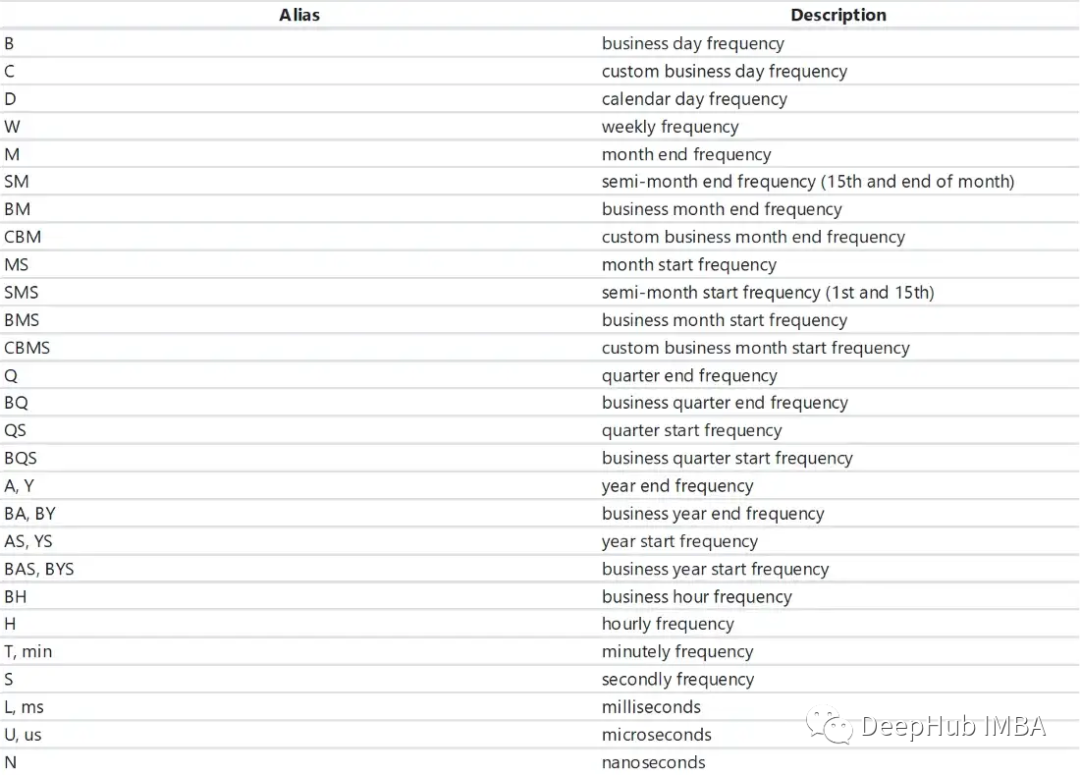
我们可以使用timedelta_range方法创建一个时间序列。
t=pd.timedelta_range(0, periods=10, freq="H")
"""
TimedeltaIndex(['0 days 00:00:00', '0 days 01:00:00', '0 days 02:00:00',
'0 days 03:00:00', '0 days 04:00:00', '0 days 05:00:00',
'0 days 06:00:00', '0 days 07:00:00', '0 days 08:00:00',
'0 days 09:00:00'],
dtype='timedelta64[ns]', freq='H')
"""
格式化
我们dt.strftime方法改变日期列的格式。
df["new_date"] =df["date"].dt.strftime("%b %d, %Y")
df.head()
"""
date value new_date
0 1991-07-01 3.526591 Jul 01, 1991
1 1991-08-01 3.180891 Aug 01, 1991
2 1991-09-01 3.252221 Sep 01, 1991
3 1991-10-01 3.611003 Oct 01, 1991
4 1991-11-01 3.565869 Nov 01, 1991
"""
解析
解析datetime对象并获得日期的子对象。
df["year"] =df["date"].dt.year
df["month"] =df["date"].dt.month
df["day"] =df["date"].dt.day
df["calendar"] =df["date"].dt.date
df["hour"] =df["date"].dt.time
df.head()
"""
date value year month day calendar hour
0 1991-07-01 3.526591 1991 7 1 1991-07-01 00:00:00
1 1991-08-01 3.180891 1991 8 1 1991-08-01 00:00:00
2 1991-09-01 3.252221 1991 9 1 1991-09-01 00:00:00
3 1991-10-01 3.611003 1991 10 1 1991-10-01 00:00:00
4 1991-11-01 3.565869 1991 11 1 1991-11-01 00:00:00
"""
还可以重新组合它们。
df["date_joined"] =pd.to_datetime(df[["year","month","day"]])
print(df["date_joined"])
"""
0 1991-07-01
1 1991-08-01
2 1991-09-01
3 1991-10-01
4 1991-11-01
...
199 2008-02-01
200 2008-03-01
201 2008-04-01
202 2008-05-01
203 2008-06-01
Name: date_joined, Length: 204, dtype: datetime64[ns]
过滤查询
使用loc方法来过滤DataFrame。
df=df.loc["2021-01-01":"2021-01-10"]
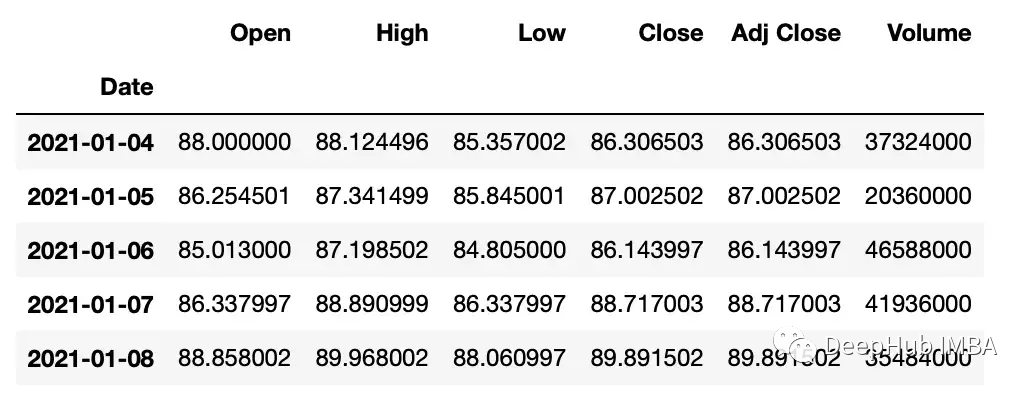
truncate 可以查询两个时间间隔中的数据
df_truncated=df.truncate('2021-01-05', '2022-01-10')
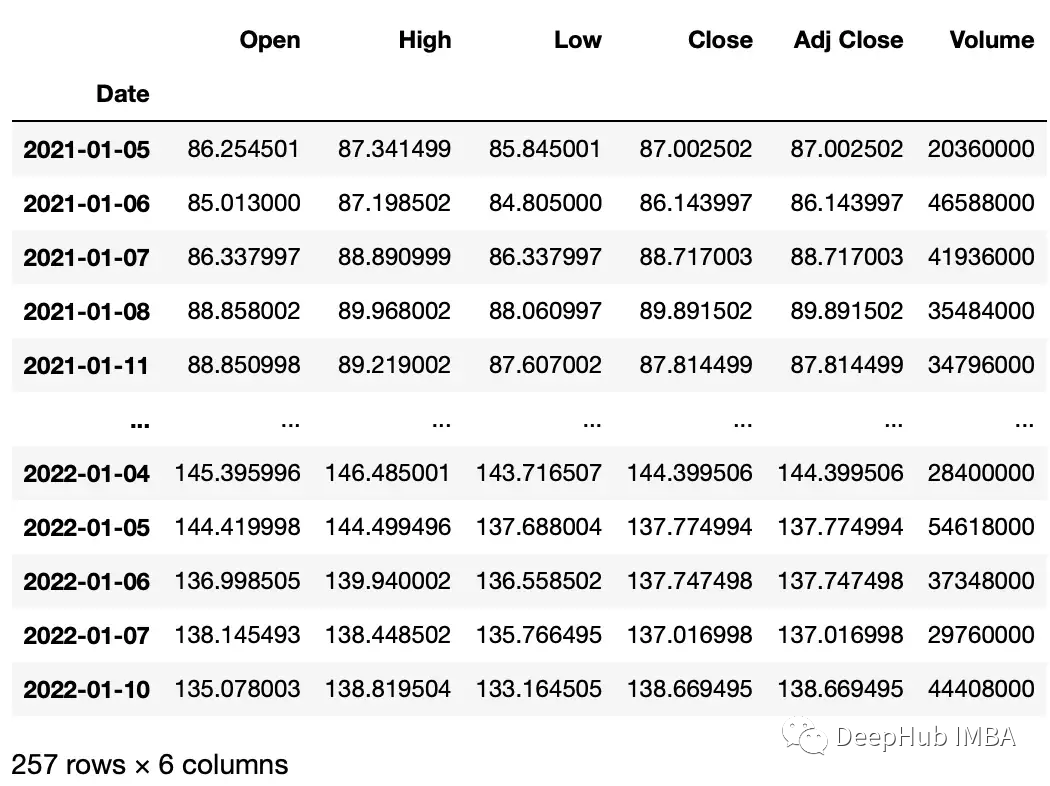
常见数据操作
下面就是对时间序列数据集中的值执行操作。我们使用yfinance库创建一个用于示例的股票数据集。
#get google stock price data
importyfinanceasyf
start_date='2020-01-01'
end_date='2023-01-01'
ticker='GOOGL'
df=yf.download(ticker, start_date, end_date)
df.head()
"""
Date Open High Low Close Adj Close Volume
2020-01-02 67.420502 68.433998 67.324501 68.433998 68.433998 27278000
2020-01-03 67.400002 68.687500 67.365997 68.075996 68.075996 23408000
2020-01-06 67.581497 69.916000 67.550003 69.890503 69.890503 46768000
2020-01-07 70.023003 70.175003 69.578003 69.755501 69.755501 34330000
2020-01-08 69.740997 70.592499 69.631500 70.251999 70.251999 35314000
"""
计算差值
diff函数可以计算一个元素与另一个元素之间的插值。
#subtract that day's value from the previous day
df["Diff_Close"] =df["Close"].diff()
#Subtract that day's value from the day's value 2 days ago
df["Diff_Close_2Days"] =df["Close"].diff(periods=2)

累计总数
df["Volume_Cumulative"] =df["Volume"].cumsum()

滚动窗口计算
滚动窗口计算(移动平均线)。
df["Close_Rolling_14"] =df["Close"].rolling(14).mean()
df.tail()

可以对我们计算的移动平均线进行可视化
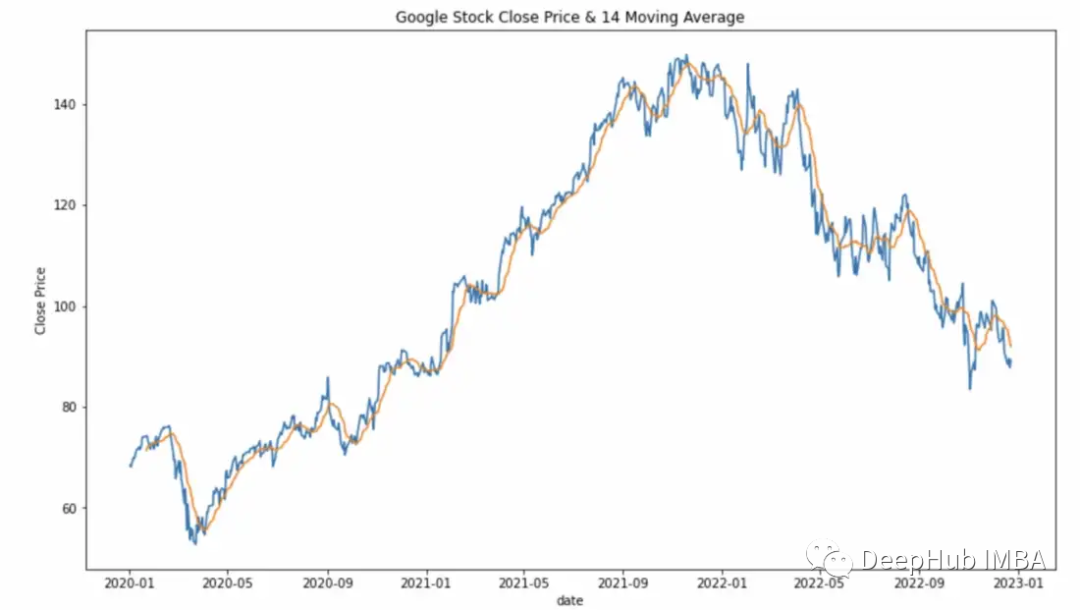
常用的参数:
- center:决定滚动窗口是否应以当前观测值为中心。
- min_periods:窗口中产生结果所需的最小观测次数。
s=pd.Series([1, 2, 3, 4, 5])
#the rolling window will be centered on each observation
rolling_mean=s.rolling(window=3, center=True).mean()
"""
0 NaN
1 2.0
2 3.0
3 4.0
4 NaN
dtype: float64
Explanation:
first window: [na 1 2] = na
second window: [1 2 3] = 2
"""
# the rolling window will not be centered,
#and will instead be anchored to the left side of the window
rolling_mean=s.rolling(window=3, center=False).mean()
"""
0 NaN
1 NaN
2 2.0
3 3.0
4 4.0
dtype: float64
Explanation:
first window: [na na 1] = na
second window: [na 1 2] = na
third window: [1 2 3] = 2
"""
平移
Pandas有两个方法,shift()和tshift(),它们可以指定倍数移动数据或时间序列的索引。Shift()移位数据,而tshift()移位索引。
#shift the data
df_shifted=df.shift(5,axis=0)
df_shifted.head(10)
#shift the indexes
df_tshifted=df.tshift(periods=4, freq='D')
df_tshifted.head(10)
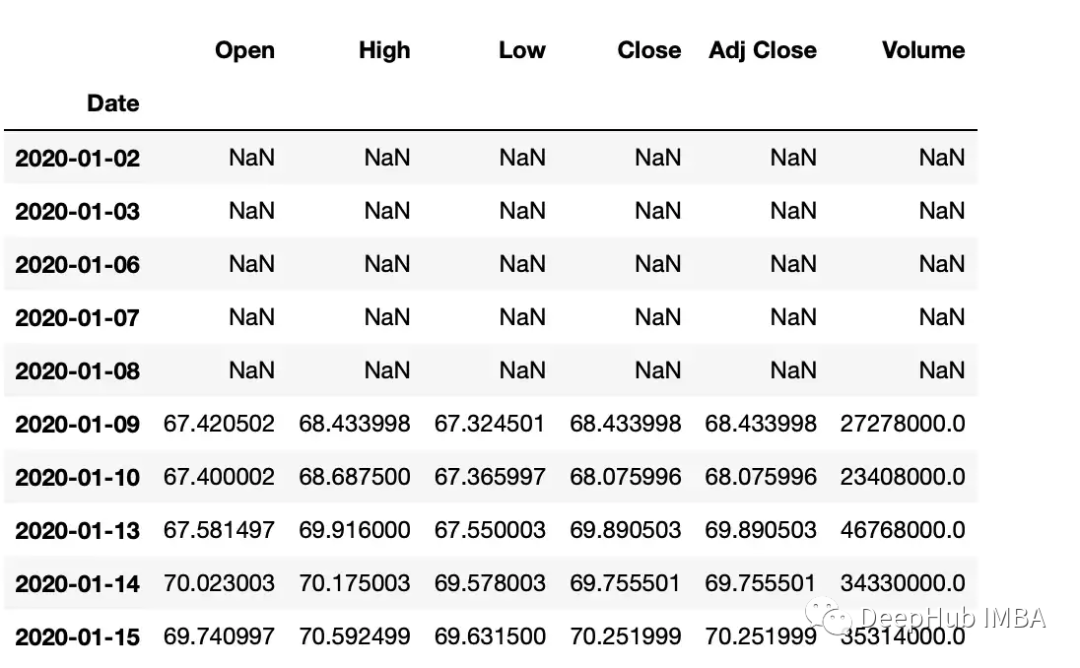
df_shifted
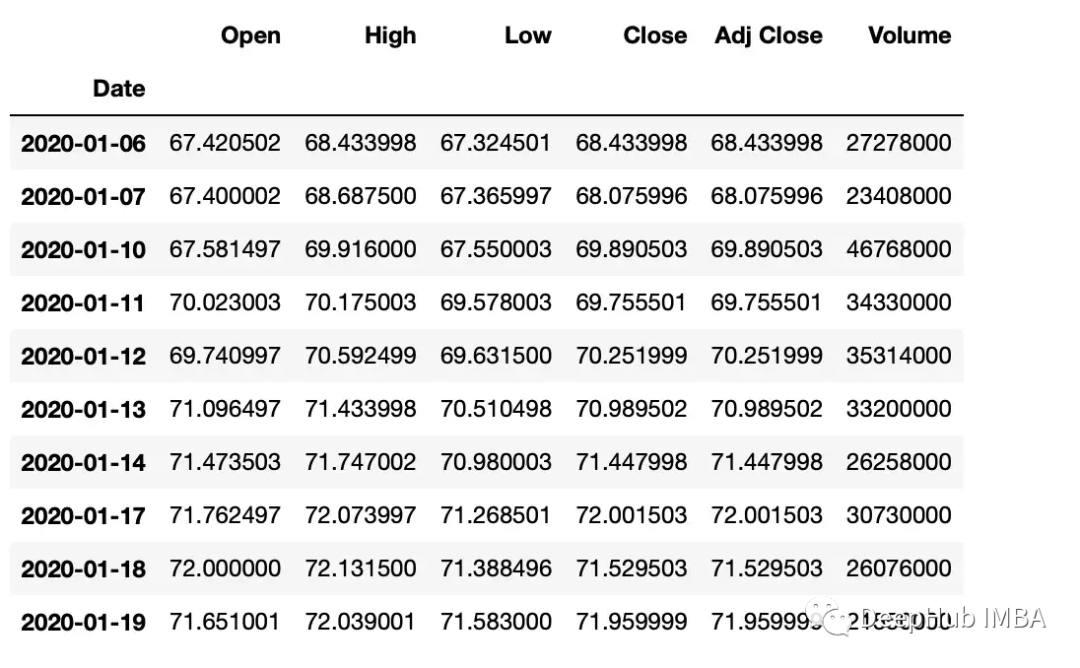
df_tshifted
时间间隔转换
在 Pandas 中,操 to_period 函数允许将日期转换为特定的时间间隔。可以获取具有许多不同间隔或周期的日期
df["Period"] =df["Date"].dt.to_period('W')

频率
Asfreq方法用于将时间序列转换为指定的频率。
monthly_data=df.asfreq('M', method='ffill')
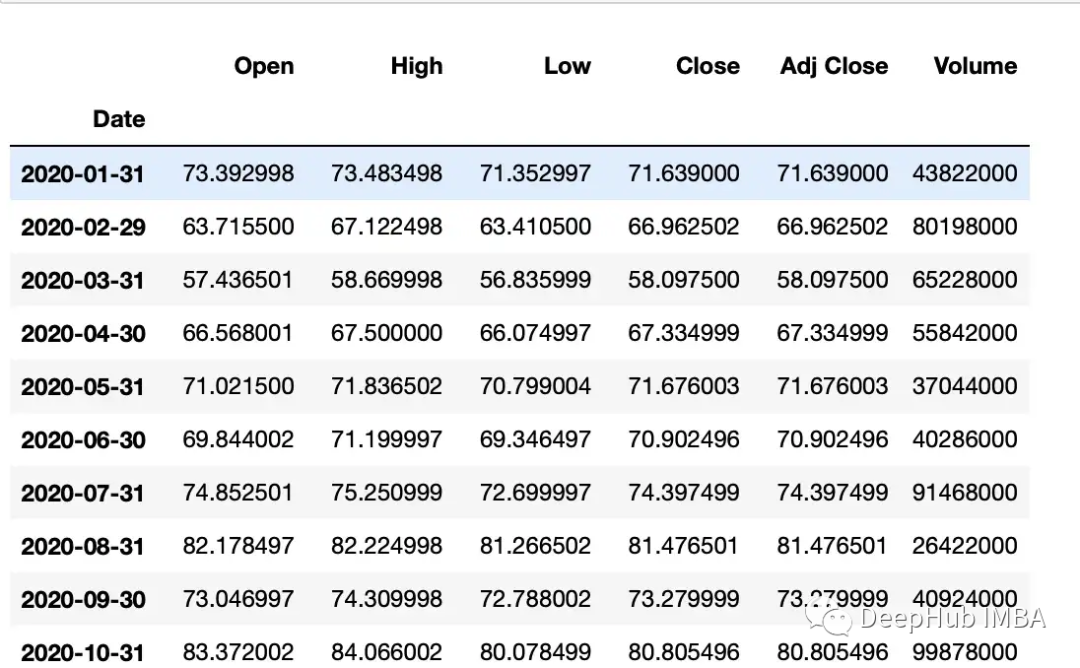
常用参数:
freq:数据应该转换到的频率。这可以使用字符串别名(例如,'M'表示月,'H'表示小时)或pandas偏移量对象来指定。
method:如何在转换频率时填充缺失值。这可以是'ffill'(向前填充)或'bfill'(向后填充)之类的字符串。
采样
resample
可以改变时间序列频率并重新采样。我们可以进行上采样(到更高的频率)或下采样(到更低的频率)。因为我们正在改变频率,所以我们需要使用一个聚合函数(比如均值、最大值等)。
resample方法的参数:
rule:数据重新采样的频率。这可以使用字符串别名(例如,'M'表示月,'H'表示小时)或pandas偏移量对象来指定。
#down sample
monthly_data=df.resample('M').mean()
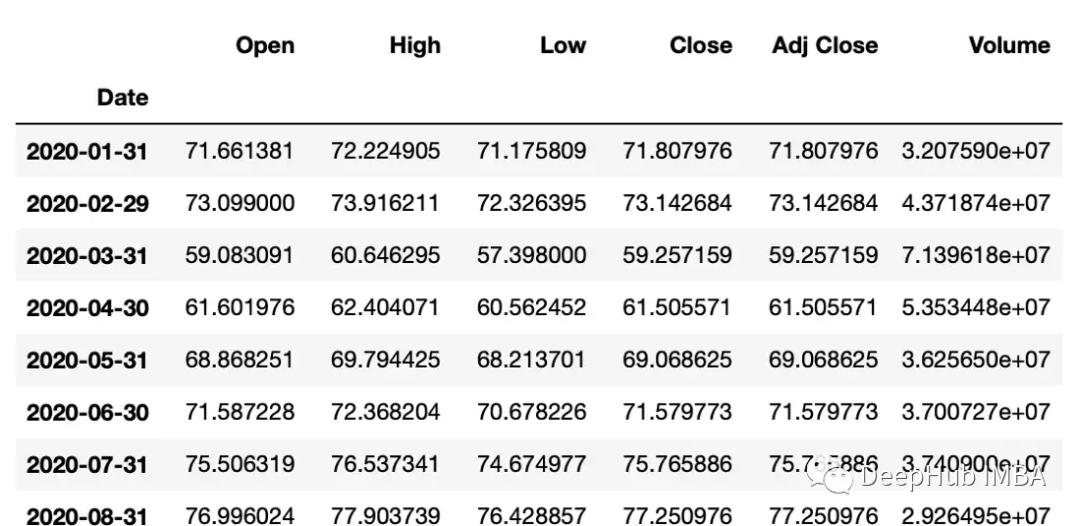
#up sample
minute_data=data.resample('T').ffill()
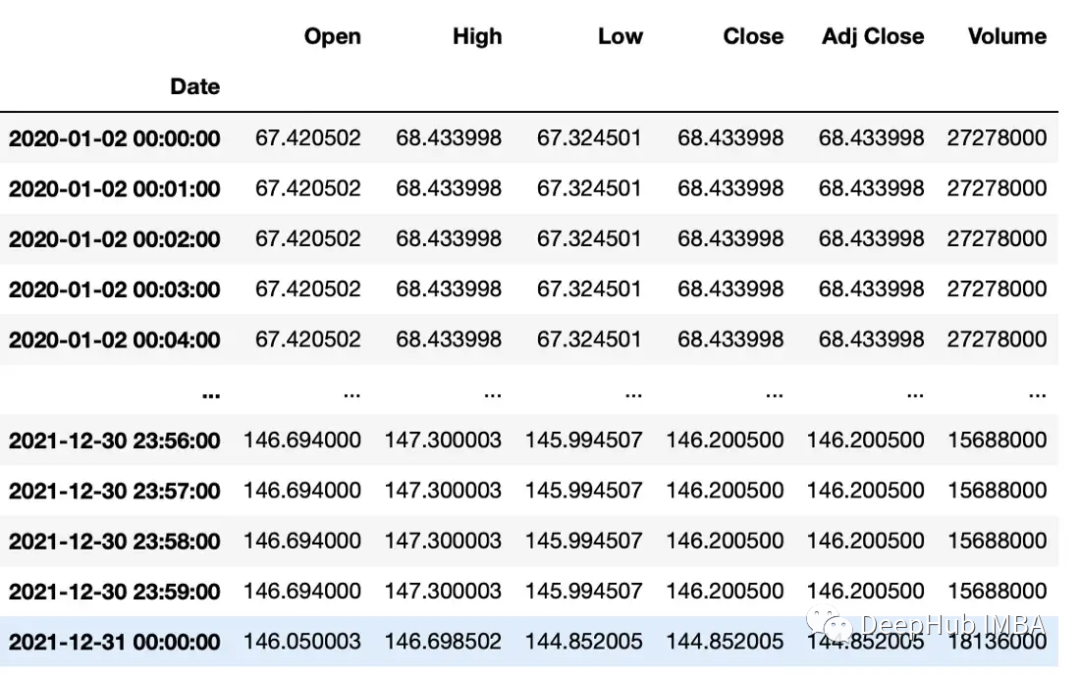
百分比变化
使用pct_change方法来计算日期之间的变化百分比。
df["PCT"] =df["Close"].pct_change(periods=2)
print(df["PCT"])
"""
Date
2020-01-02 NaN
2020-01-03 NaN
2020-01-06 0.021283
2020-01-07 0.024671
2020-01-08 0.005172
...
2022-12-19 -0.026634
2022-12-20 -0.013738
2022-12-21 0.012890
2022-12-22 -0.014154
2022-12-23 -0.003907
Name: PCT, Length: 752, dtype: float64
"""
总结
在Pandas和NumPy等库的帮助下,可以对时间序列数据执行广泛的操作,包括过滤、聚合和转换。本文介绍的是一些在工作中经常遇到的常见操作,希望对你有所帮助。
作者:Okan Yenigün